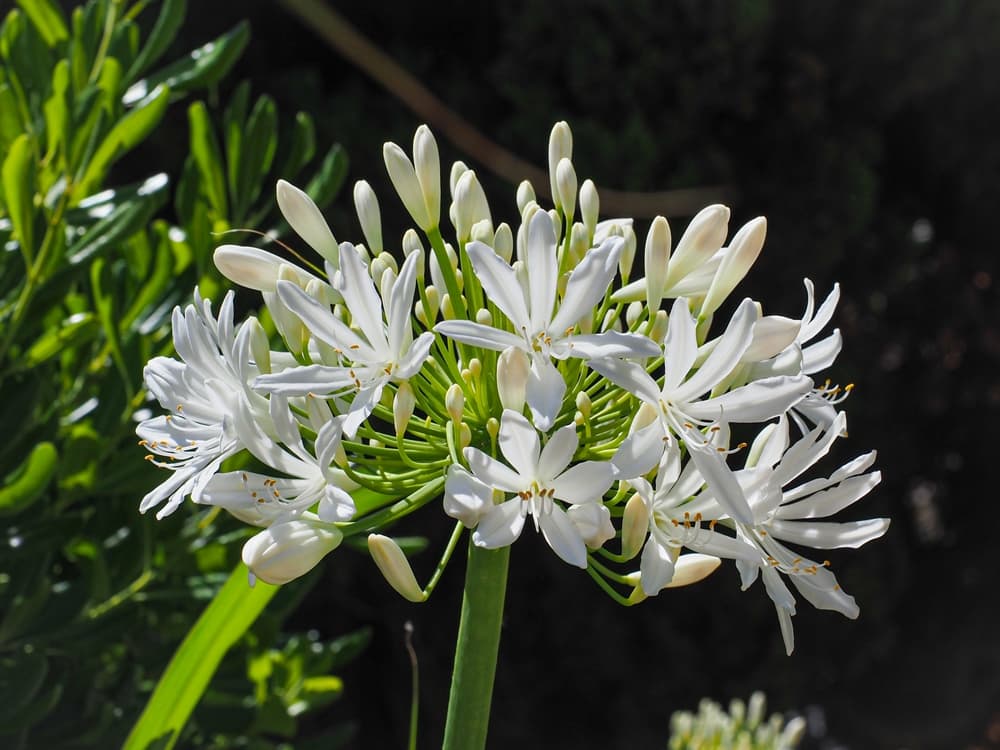16 Stunning Agapanthus Varieties With Advice From Patrick Fairweather

PERENNIALS > AGAPANTHUS > VARIETIES

Elizabeth is a Permaculture Garden Designer, Sustainability Consultant and Professional Writer, working as an advocate for positive change. She graduated from the University of St. Andrews with an MA in English and Philosophy and obtained a Diploma in Applied Permaculture Design from the Permaculture Association.
Reviewed By COLIN SKELLY

Colin is a Horticulturist and Horticultural Consultant with experience in a range of practical and managerial roles across heritage, commercial and public horticulture. He holds the Royal Horticultural Society’s Master of Horticulture award and has a particular interest in horticultural ecology and naturalistic planting for habitat and climate resilience.
Contributions From PATRICK FAIRWEATHER

Patrick is the MD of Fairweather’s Nursery, which is home to a Plant Heritage National Collection of Agapanthus. Their Allium cultivar won the HTA Plant Of The Year Award in 2021 and came 2nd in the same category at the Chelsea Flower Show in the same year. Patrick is also the Chair of the RHS Agapanthus AGM trials.
IN THIS GUIDE
- Expert Choices
- 1) A. ‘Arctic Star’
- 2) A. ‘Fireworks’
- 3) A. ‘Midnight Star’
- 4) A. ‘Hoyland Blue’
- 5) A. inapertus ‘Avalanche’
- 6) A. ‘Twister’
- 7) A. ‘Loch Hope’
- 8) A. ‘Northern Star’
- 9) A. ‘Peter Franklin’
- 10) A. ‘Royal Blue’
- 11) A. ‘Snow Cloud’
- 12) A. ‘Purple Delight’
- 13) A. ‘Peter Pan’
- 14) A. ‘Flower of Love’
- 15) A. ‘Jacaranda’
- 16) A. praecox subsp. orientalis ‘Royal Velvet’
- Key Considerations
AGAPANTHUS GUIDES
Common Problems
Container Growing
Deadheading
Propagation
– Growing From Seed
– Dividing
Pruning
Repotting
Varieties
Winter Care
Agapanthus can be great options for a container garden, or for filling gaps with beautiful blooms in a sunny, sheltered and free-draining border.
“Agapanthus is a versatile garden plant with foliage that provides structure when not in flower, which then sends out tall flower stems with striking clusters of bell-shaped flowers,” says Horticulturist Colin Skelly, who completed his Master of Horticulture qualification with the RHS.
“I have grown different varieties in mixed borders, planted as specimens and more naturalistically and in large and small pots.
“In all of these situations, they require minimal maintenance for a lot of horticultural return.”
But which variety should you grow?
Below, we list some of the excellent options to consider – all of which (except A. ‘Peter Pan’) have been given an RHS Award of Garden Merit.
Expert Choices
When building our list we spoke with Patrick Fairweather, one of the leading growers of Agapanthus in the UK and MD of Fairweather’s Nursery.
We asked him to share his favourite varieties.
“I love ‘Northern Star’, as its hardy and deciduous,” said Patrick.
“I have it in my flower beds and it comes back year after year with large, striped, dark blue flowers.”
You can find more information on ‘Northern Star’ in our detailed list below.

“‘Ever White’ is a brilliant reblooming white Agapanthus that is great in a pot or at the front of a border,” Patrick adds.
“For a dramatic patio plant in a pot, I would choose ‘Full Moon’. This is a tall variety that has large, rounded, pale blue umbels.”
Read on to discover just some of the great Agapanthus varieties that you might consider:
1) A. ‘Arctic Star’

- HARDINESS RATING: H4
- USUAL HEIGHT: 80CM
‘Arctic Star’ grows to a height of around 80cm, with a 50cm spread.
It flowers in July and August, and has creamy buds that open to pale blue/white blooms.
These contrast well with greyish-green foliage.
2) A. ‘Fireworks’

- HARDINESS RATING: H3
- USUAL HEIGHT: 60CM
‘Fireworks’ grows to around 60cm tall.
It is an evergreen type of Agapanthus, which bears round umbels of upright white buds which open to reveal trumpet-shaped blooms with purple-blue bases and white, flaring petal tips.
3) A. ‘Midnight Star’

- HARDINESS RATING: H5
- USUAL HEIGHT: 50-100CM
If you are looking for a hardier, deciduous Agapanthus with deeper blue flowers then this is an excellent choice.
The deep blue-hued blooms on this cultivar are born from mid to late summer, at a height of between 50cm and 1m.
4) A. ‘Hoyland Blue’

- HARDINESS RATING: H3/H4
- USUAL HEIGHT: 75CM
Another evergreen type, ‘Hoyland Blue’ grows to around 75cm tall.
It has broad, strap-shaped foliage above which the white to pale blue flowers tower from the late summer into autumn.
5) A. inapertus ‘Avalanche’

- HARDINESS RATING: H4
- USUAL HEIGHT: 80CM
This herbaceous perennial grows up to around 80cm in height.
It has relatively upright foliage and its stiff stems are surmounted by dangling, tubular white flowers in late summer and early in the autumn.
6) A. ‘Twister’

- HARDINESS RATING: H4
- USUAL HEIGHT: 50CM
This compact option grows only around 50cm tall.
The trumpet-shaped blooms are a deep blue-purple at the base, with white tips which flare outwards.
It is also sometimes referred to as ‘Indigo Frost’.
7) A. ‘Loch Hope’

- HARDINESS RATING: H5
- USUAL HEIGHT: 120CM
A hardier option, ‘Loch Hope’ is another good deciduous Agapanthus to consider.
It grows a little taller than options discussed thus far, to a height of around 1.2m.
It has beautiful deep blue flowers.
8) A. ‘Northern Star’

- HARDINESS RATING: H4
- USUAL HEIGHT: 80-100CM
This is another great choice if you love including plenty of blue and purple hues in your garden.
‘Northern Star’ grows up to around 1m in height, and its flowers are a deep violet-blue, with delicate purple stripes down the centre of each petal.
9) A. ‘Peter Franklin’

- HARDINESS RATING: H3
- USUAL HEIGHT: 150CM
A tall and dramatic Agapanthus, the stems on this plant can soar up to around 1.5m in height.
This is another more tender evergreen option.
The flowers on their large round umbels are a pure and pristine white.
10) A. ‘Royal Blue’

- HARDINESS RATING: H4
- USUAL HEIGHT: 75CM
With bell-shaped flowers of a vibrant violet-blue, this is another deciduous Agapanthus to consider.
The flowers are born in late summer, and grow to a height of around 75cm.
11) A. ‘Snow Cloud’

- HARDINESS RATING: H4
- USUAL HEIGHT: 120CM
With the synonym ‘Fragrant Snow’, this Agapanthus lives up to its names, bearing beautiful loose balls of snowy white flowers in the summer months.
The erect stems on this cultivar can grow to a height of around 1.2m.
12) A. ‘Purple Delight’

- HARDINESS RATING: H3
- USUAL HEIGHT: 90CM
The name rather gives it away – the flowers of this variety of Agapanthus are indeed a lovely purple hue.
The purple funnel-shaped flowers in their rounded umbels appear from mid-summer to early autumn.
Their stems grow to a height of around 90cm.
13) A. ‘Peter Pan’

- HARDINESS RATING: H4
- USUAL HEIGHT: 50CM
This is a dwarf Agapanthus that will grow to a maximum of half a metre.
This variety has beautiful lilac and white striped flowers and contrasting yellow stamen which will stand out in any garden.
This is the only type of Agapanthus on our list which has not received the RHS AGM.
14) A. ‘Flower of Love’
- HARDINESS RATING: H4
- USUAL HEIGHT: 50CM
This compact deciduous Agapanthus has lovely deep blue flowers, born on upright stems that grow to around 50cm tall.
This Agapanthus is in bloom through the summer months.
15) A. ‘Jacaranda’
- HARDINESS RATING: H4
- USUAL HEIGHT: 90CM
This is an evergreen Agapanthus with purple-blue flowers, with deeper stripes down the heart of each petal.
This is an earlier flowering type, and bears its flowers on 90cm high stems between June and August.
16) A. praecox subsp. orientalis ‘Royal Velvet’
- HARDINESS RATING: H4
- USUAL HEIGHT: 75CM
This Agapanthus grows to a height of around 75cm.
The rounded flower heads are a deep purple, with a darker central stripe down each one.
There is also a purple tinge around the base of the leaves and flower stems.
Key Considerations
When choosing an Agapanthus, the first thing to consider is the hardiness of the variety you are considering.
Hardiness
Some can overwinter outdoors with some protection, while others are definitely more tender and will usually need to be brought undercover into an unheated greenhouse for the winter months.
They range from half-hardy (H3), requiring a very mild winter or an unheated greenhouse to H5 (hardy through most of the UK even during extreme winters).
Deciduous types are generally hardier, and evergreens more tender, but hardiness rating can vary even within each of these two categories.
Colour
Of course, another key consideration will be colour.
Many Agapanthus are in shades of purple-blue, but there are white options.
And some have bi-coloured flowers.
Height
Some larger, taller Agapanthus will work best in a border, while more compact options are often better choices for containers.
